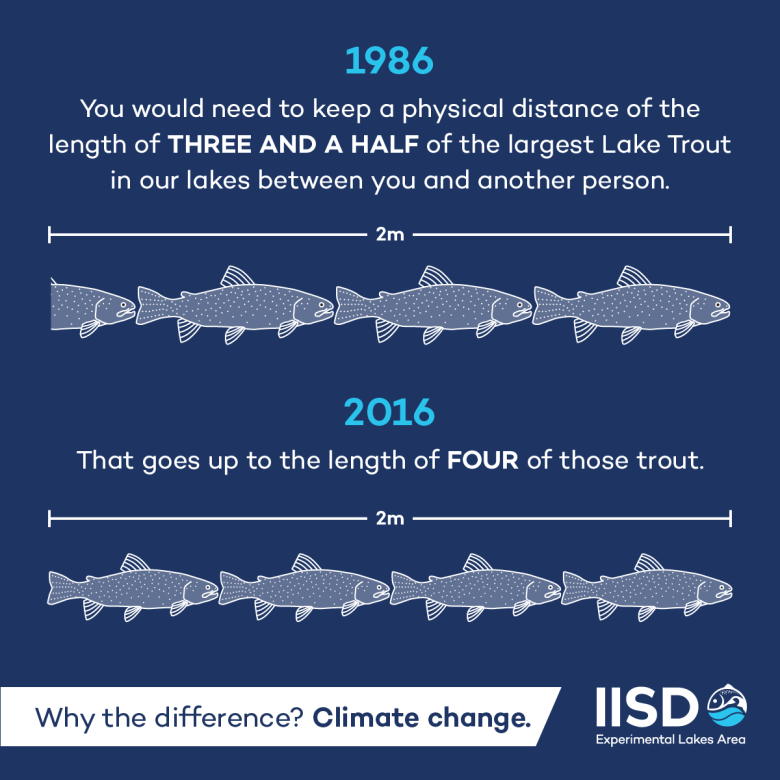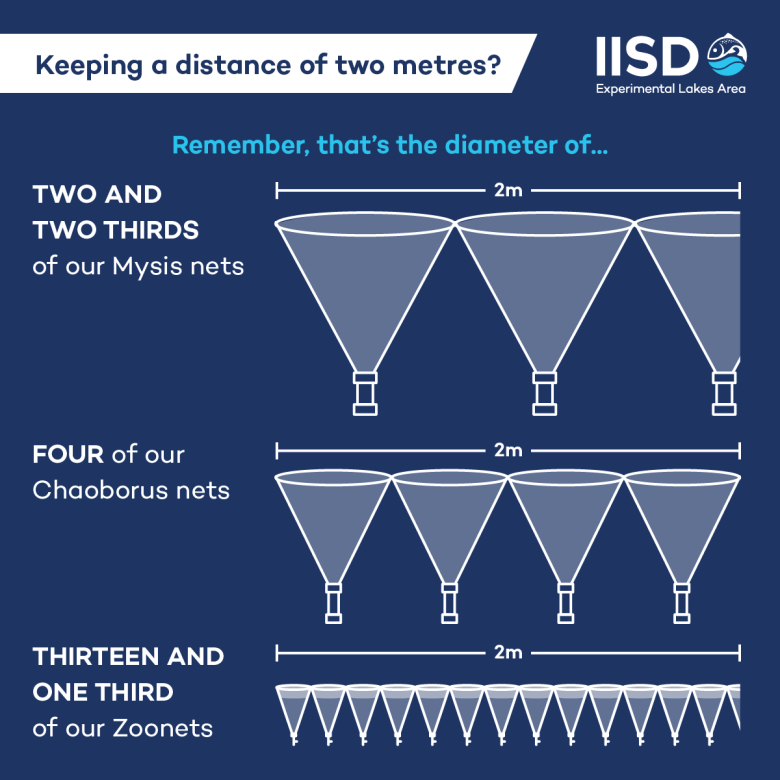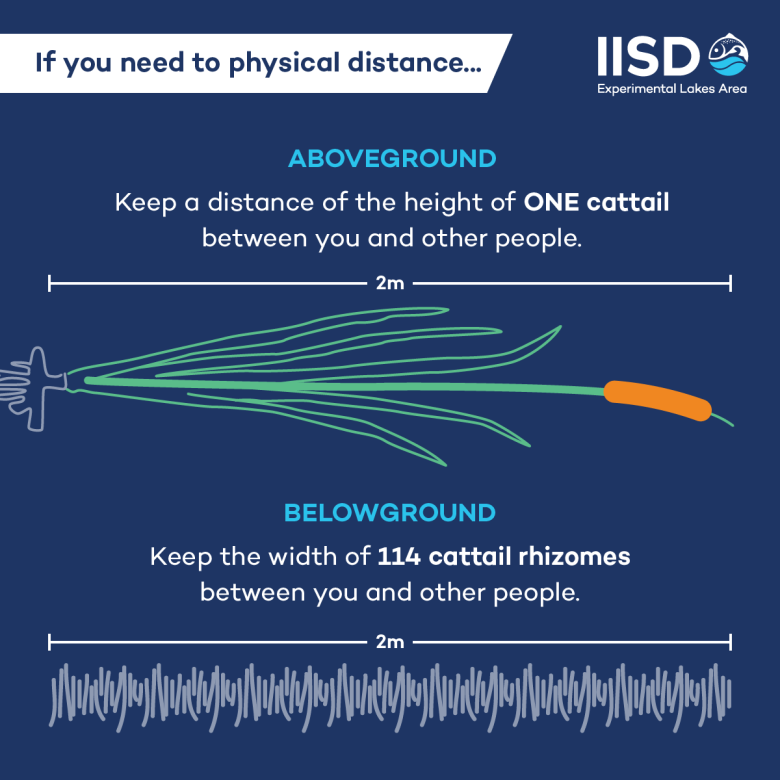Research April 28, 2020
Physical Distancing? Here’s what 2 metres means in the world of freshwater science
By Lauren Hayhurst, Fisheries Research Biologist, Sumeep Bath, Communications Manager
In these challenging times, we all know we need to be keeping a minimum physical distance of two metres between ourselves and others—that doesn’t mean we need to distance ourselves from freshwater science, though!
In the midst of condensing our spring field season, minimizing on-site personnel, and rearranging field sampling schedules, we paused to provide our own (fresh) freshwater take on what two metres looks like.
Here we suggest how many fish or zooplankton nets or cattails you need to keep between yourself and other people.
At the same time, we provide you with some lesser-known facts about our fresh water along the way!
“I Caught a Fish That Was THIS BIG”—Then and now
What’s the Species?
Lake trout (Salvelinus namaycush), a well-studied predatory fish species common in IISD-ELA lakes.
What’s the Distance?
When we measured lake trout in reference Lake 373 in 1986, the maximum total length (considering the largest 5% of fish captured that year) was 57 centimetres, or about 22 inches.
That means in 1986, you would have needed to keep exactly THREE AND A HALF of the largest lake trout (nose-to-tail) that you caught from IISD-ELA’s reference Lake 373 between you and another person.
However, when we measured lake trout in the same lake in 2016, the maximum total length (again, considering the largest 5% of fish) was 49 centimetres, or about 19 inches.
Now, practicing freshwater social distancing, you would need to keep at least FOUR of the largest lake trout caught from reference Lake 373 between you and another person.
This 30-year, 3-inch difference is evidence of climate change.

What’s the Science?
We have been monitoring lake trout at IISD-ELA since the 1970s, along with lake temperatures and ice-free periods, and have observed changes in both the length of Lake Trout and the length of the summer period.
Given that lake trout are a cold-water species, longer periods with warmer lake temperatures restrict the movement of these predatory fish within the water column, which affects their forage base (the space in which they can find food), as the warming temperatures within the water column limit their access to prey.
Researchers analyzed changes in the length of adult lake trout (largest 5% of population) over time. Over decades, climate change has created a pattern of sub-optimal conditions for lake trout, which is evidenced by the fact they have been getting smaller over time. As air temperatures and the length of warmer periods increase, these changes are expected to continue.
Something to keep in mind: our fish run (swim) small at IISD-ELA, as they inhabit small oligotrophic (low-nutrient) environments. There would be discrepancies in these lake trout measurements compared to fish you may encounter in large eutrophic (high-nutrient) systems, where the total length may be much greater. Even so, these fish are similarly decreasing in size over time, as climate change is not limited to the nutrient and size constraints of a pristine Shield lake and instead has wide-ranging effects.
Netting Yourself Some Physical Distance
What’s the Equipment?
Zooplankton nets are commonly used to collect invertebrates within the water column, in IISD-ELA’s experimental and reference lakes alike.
What’s the Distance?
Mysis nets are used in a study where we are reintroducing Mysis sp.—a
species that has disappeared from a lake due to research on acid rain—and to
monitor lake recovery from past research on aquaculture.
Considering these nets have a diameter of 0.75-metres, you should keep a minimum of TWO AND TWO THIRDS Mysis nets between yourself and other people.
Chaoborus nets will be used in an upcoming study on the impact of microplastics on the health of a freshwater lake. Chaoborus spp.
are not actually zooplankton, they are the larval stage of phantom midges, and
they cannot move as fast as Mysis sp. away from our hauls, so
we can opt for a narrower net opening.
Considering these nets have a diameter of 0.5-metres, 2 metres of social distancing equates to FOUR Chaoborus nets.
Zoonets are the all-encompassing default zooplankton nets that we deploy in most of IISD-ELA’s reference lakes and many experimental lakes.
Considering these nets have a diameter of 0.15-metres, you will require the distance of a whopping THIRTEEN AND ONE THIRD zoonets between yourself and another person.

What’s the Science?
Zooplankton are small invertebrates that live in the water column of most bodies of water. While they feed on bacteria, algae, and other zooplankton, they are a food source for predatory invertebrates and fish. IISD-ELA has been collecting zooplankton samples for its entire 52-year history. In addition to water samples that can provide a snapshot of the physical and chemical components of water quality, zooplankton live and move in the water, and thus provide an ongoing video of lake health.
Net sizes are selected to ensure that they are big enough to collect the zooplankton living and moving within the water column, but also small enough to portage across trails (without too much inconvenience) and deploy and haul up in numerous and repeated zooplankton station locations in a lake. Common throughout are our efforts to keep our sampling methodology as consistent as possible – whether this is over time or across lakes, we have a lot of factors to consider in our lot of sampling!
Zoonets are our most convenient zooplankton collectors, so we default to this size at every opportunity (historically and presently), as it provides us with a good representative sample of the water column’s invertebrates. Considering the inconsistent nature of field research, we try to be as consistent as possible in the ways we collect our data and specimens!
NOTE: Generally, Chaoborus spp. and Mysis sp. do not overlap in our lakes, since they occupy similar niches in the ecosystem and directly compete with each other for the same resources —often one will triumph over the other based on how favourable the conditions of the lake are for them. Occasionally, we encounter Mysis sp. in Chaoborid-dominated lakes, and vice versa, especially where lakes are connected by short inflows that invertebrates can access. However, we may have found an exception in our upcoming microplastics study lake, where both species appear to be present despite the absence of accessible inflows.
Stay tuned.
Try to Avoid Clustering Together Like Cattails
What’s the species?
Cattail (Typha spp. ), widespread in Manitoba, are commonly used in our Floating Treatment Wetlands.
What’s the Distance?
If you find yourself having to keep social distance above ground, cattails are, on average, 2 metres tall (the range is about 1 to 3 metres), so remember to keep the height of ONE cattail between you and other people.
If you found yourself having to keep social distance below ground, cattail rhizomes are, on average, 1.75 centimetres wide (they range from 0.5 to 3 centimetres). Rhizome is Greek for “mass of roots,” though rhizomes are modified below-ground plant stems, which can send up above-ground shoots and act as nutrient storage for the plant stalk. Therefore, remember to keep the width of at least 114 cattail rhizomes between you and other people.

What’s the Science?
Cattails are great natural bioremediators, which means they are capable of naturally treating and detoxifying environmental contaminants in soil, water, and the environment.
But the stalks you see above ground, which provide an easy measure of physical distancing, are not even half of the story. Below ground, their rhizomes and the biofilm (algae, bacteria, fungi, and microbes) that develops on their underground roots, uptake and degrade most of the nutrients, contaminants, and toxins in freshwater.
Floating treatment wetlands are artificial constructs that work to stimulate these natural processes by providing a supportive framework for the cattails and their root networks, which can be set in inaccessible deeper water away from their regularly inhabited structural shorelines.
There is huge potential to implement floating treatment wetlands in different aquatic environments that may have issues with excess nutrients or toxins and even after oil spills, as we are exploring at the world’s freshwater laboratory.
Together, we continue to make strides both in freshwater science and in reducing the spread and scale of COVID-19. From all of us at IISD-ELA, we encourage you to stay socially distanced, stay healthy, and stay science savvy!
You know that groundbreaking freshwater research you just read about? Well, that’s actually down to you.
We know that these are difficult times, but it’s only thanks to our generous donors that the world’s freshwater laboratory—an independent not-for-profit—can continue to do what we do.
If you believe in whole ecosystem science and using it to bring about real change to fresh water around the globe, please support us in any way you are able to.